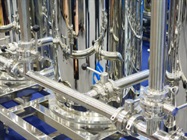
Filtration is a process in which solid particulate matter is removed from a fluid, which can be either liquid or gas, using a porous medium for the process. Filtration can be easily applied to a large variety of pharmaceutical needs, and because of this flexibility it is widely used within the industry.
The pharmaceutical industry needs different filtration methods depending on what sort of solution is being used. Here are some of the most commonly used technologies:
Surface filtration: Surface filtration works by direct interception. The size of the pores of the filter is responsible for the separation as the screen allows particles of a specific size through but traps molecules that are too large to fit through the pores. Because a porous membrane is sometimes used, the system is also referred to as
membrane filtration.
Depth filtration: Compared to surface filtration, depth filtration also retains particulate matter farther down from the surface. It is primarily used for clarification of solutions. Among the most common filters used in depth filtration are ceramic-filtered and sintered filters.
Cross-flow filtration: The most typical example of
cross-flow filtration is nanofiltration, designed for use by companies needing a method for dealing with low total dissolved solids water. The name nanofiltration comes from the use of a filtration membrane that has pores that are at or below one nanometer in diameter.
Ultra filtration: Ultra filtration is a pressure-driven membrane transport process that is best used in separation, concentration and purification of specific macromolecules. This method of filtration generates a high level of purity in its products, and industrially it is applied to the production of vaccines, plasma and serums.
Cake filtration: The pharmaceutical industry also employs cake filtration. A surface filtration technique at its core, this system uses the cake formed at the surface of the membrane to increase the efficiency of the filtration system. The filter is usually composed of coarse woven cloth. Through this cloth, a medium is run so that the particles within the solution bridge the holes in the fabric and provide a more robust membrane. The cake can remove sub-micrometer colloidal particles with a high degree of efficiency.
As shown above, across all the areas of pharmaceutical production, there are multiple methodologies for filtration systems. Each application is specific in what it filters, and the mechanisms used to achieve the final product. Surface and deep filtration both have their uses within the industry. As technology advances, both existing and new methods of filtration can capitalize on better, more efficient filters and methods of employing them within the pharmaceutical industry.
Follow Us
Keep up with our latest articles, news and events. Plus, get special offers and
more delivered to your inbox.